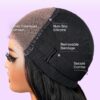When shopping on Amazon, one of the key factors to consider when making a purchase is the star rating and the breakdown by percentage. This information gives you a quick overview of what other customers think about the product and can help you make an informed decision. But have you ever wondered how Amazon calculates these ratings?
To calculate the overall star rating, Amazon doesn’t just take a simple average of all the individual ratings. Instead, their system considers a variety of factors to ensure that the rating is as accurate and reliable as possible. One of the key factors is the recency of the review – more weight is given to recent reviews, as they are likely to be more relevant and reflective of the current quality of the product.
Another important factor is whether the reviewer actually purchased the item on Amazon. Reviews from verified purchasers are given more weight, as they are considered to be more trustworthy. Amazon also analyzes reviews to detect any patterns of suspicious behavior, such as fake reviews or review manipulation, in order to maintain the integrity of the rating system.
The percentage breakdown by star is another useful tool to quickly see how many customers rated the product highly, moderately, or poorly. This breakdown can give you a better understanding of the overall sentiment towards the product and help you make a more informed decision.
In conclusion, when shopping on Amazon, it’s important to pay attention to the star rating and percentage breakdown of reviews. By understanding how these ratings are calculated and what factors are taken into account, you can make better decisions and have a more positive shopping experience. When shopping on Amazon, it’s important to pay attention to the overall star rating and percentage breakdown by star for each product you’re considering. This information can give you valuable insights into the quality and performance of the item, helping you make an informed purchasing decision.
At Amazon, the star rating system is used to collect feedback from customers who have purchased and used the product. The rating ranges from 1 to 5 stars, with 5 stars being the highest rating possible. To calculate the overall star rating, Amazon takes into account the average rating given by all customers who have left a review for the product.
In addition to the overall star rating, Amazon also provides a percentage breakdown by star. This breakdown shows the percentage of reviews that received each star rating, giving you a more detailed look at how customers have rated the product. For example, a product with a 4-star rating may have a breakdown of 50% 5-star reviews, 30% 4-star reviews, 15% 3-star reviews, 3% 2-star reviews, and 2% 1-star reviews.
When evaluating the star rating and percentage breakdown of a product on Amazon, it’s important to consider factors such as the number of reviews, the credibility of the reviewers, and the relevance of the reviews to your own needs and preferences. Keep in mind that a product with a lower star rating may still be a good fit for you if the negative reviews are based on factors that are not important to you.
To ensure that the reviews you’re reading are trustworthy, Amazon has implemented measures to verify the authenticity of reviews. This includes analyzing the timing of reviews, checking if the reviewer purchased the product on Amazon, and using algorithms to detect suspicious patterns in review activity.
In conclusion, when shopping on Amazon, pay close attention to the overall star rating and percentage breakdown by star for each product you’re considering. This information can help you gauge the quality and performance of the item, and make a more informed purchasing decision. And remember, always read reviews with a critical eye and consider how they align with your own needs and preferences. When shopping on Amazon, one of the key factors to consider before making a purchase is the overall star rating of a product. This rating is a helpful indicator of the quality and satisfaction level of the item based on feedback from other customers. However, it’s important to understand that the star rating is not the only factor to consider when evaluating a product.
At Amazon, the star rating is calculated based on a variety of factors, including the number of reviews a product has received and the average rating given by those reviewers. This information is used to provide an overall rating that gives potential buyers a quick snapshot of how well a product is received by others.
In addition to the star rating, Amazon also provides a percentage breakdown by star, which can give you a more detailed understanding of how reviewers feel about a product. For example, you may see that a product has a 4-star rating, but upon further inspection, you see that the majority of reviews are 5 stars, indicating that most customers are highly satisfied with the product.
It’s important to note that Amazon’s system takes into account the recency of reviews and whether the reviewer actually purchased the item on Amazon. This helps to ensure that the reviews are legitimate and trustworthy, giving you more confidence in your purchasing decision.
When considering a product on Amazon, be sure to take the overall star rating into account, but also delve deeper into the percentage breakdown by star and read individual reviews to get a comprehensive understanding of the product. By doing so, you can make a more informed decision and feel confident in your purchase. When shopping on Amazon, one of the most important factors to consider before making a purchase is the overall star rating of a product. While a high star rating can indicate a quality product, it’s also important to dig deeper and look at the percentage breakdown by star to get a more accurate picture of what previous customers think.
At Amazon, the star rating system is based on a scale of 1 to 5 stars, with 1 being the lowest and 5 being the highest. But simply looking at the average star rating can be misleading, as it doesn’t take into account the distribution of ratings. This is where the percentage breakdown by star comes in handy.
By looking at the percentage breakdown, you can see how many customers rated the product 5 stars, 4 stars, 3 stars, 2 stars, and 1 star. This information can give you a better idea of the overall satisfaction level of customers who have purchased the product. For example, a product may have a high average star rating, but a closer look at the breakdown may reveal that a large percentage of customers rated it 1 or 2 stars, indicating potential issues with the product.
In addition to the star rating and percentage breakdown, Amazon also takes into account the recency of reviews and whether the reviewer actually purchased the item on Amazon. This helps to ensure that the reviews are trustworthy and not manipulated by fake reviews or biased opinions.
So next time you’re shopping on Amazon, be sure to take a closer look at the star rating and percentage breakdown by star to get a more accurate picture of the product’s quality. And remember, always read the reviews and consider the trustworthiness of the reviewers before making a purchase. Happy shopping! When shopping on Amazon, it’s important to pay attention to the star rating and reviews of a product to ensure you’re making a well-informed purchase. The star rating is a quick way to gauge the quality of a product, but it’s important to dig deeper and read the reviews to get a more comprehensive understanding.
At Amazon, the star rating is calculated based on a variety of factors, including the overall sentiment of the reviews, the number of reviews, and the recency of the reviews. This means that a product with a high star rating may not necessarily be the best choice for you if the reviews are outdated or if there are only a few reviews.
One key factor to consider when looking at the star rating is the breakdown by star. This can give you a better idea of the distribution of reviews and help you understand the strengths and weaknesses of the product. For example, a product with mostly 5-star reviews may be highly rated overall, but if there are a significant number of 1-star reviews, it’s important to take that into consideration.
In addition to the star rating, Amazon also analyzes reviews to verify trustworthiness. This means that they use algorithms to detect and remove fake or biased reviews, ensuring that you’re getting honest feedback from real customers. This can give you more confidence in the reviews you’re reading and help you make a more informed decision.
Overall, when shopping on Amazon, it’s important to look beyond the star rating and read the reviews to get a full picture of the product. By considering factors like the breakdown by star and the trustworthiness of the reviews, you can make a more informed decision and have a better shopping experience. When shopping on Amazon, one of the most important factors to consider when making a purchase is the overall star rating and percentage breakdown by star. This information gives you valuable insight into the quality and reliability of a product, helping you make an informed decision before hitting the “add to cart” button.
At Amazon, the star rating system is a key tool for both shoppers and sellers. To calculate the overall star rating, Amazon takes into account a variety of factors, including the number of reviews a product has received and the average rating given by those reviewers. This helps to ensure that the star rating is an accurate reflection of the overall customer satisfaction with the product.
In addition to the overall star rating, Amazon also provides a percentage breakdown by star. This breakdown shows you the percentage of reviews that fall into each star category, giving you a more detailed look at how customers have rated the product. For example, a product with a high percentage of 5-star reviews is likely to be very well-received by customers, while a product with a high percentage of 1-star reviews may have some serious flaws.
When using the star rating and percentage breakdown to evaluate a product on Amazon, it’s important to consider the context of the reviews. Factors such as the number of reviews, the recency of the reviews, and whether the reviewer actually purchased the item on Amazon can all impact the reliability of the rating. Amazon’s system takes these factors into consideration when calculating the overall star rating, helping to ensure that it is a true reflection of customer satisfaction.
In conclusion, when shopping on Amazon, be sure to pay attention to the overall star rating and percentage breakdown by star. These tools can provide valuable insights into the quality and reliability of a product, helping you make an informed decision before making a purchase. And remember, always take the time to read reviews and consider the context before making your final decision. When it comes to shopping on Amazon, one of the most important factors to consider is the overall star rating of a product. But did you know that this star rating is not just a simple average? In fact, Amazon uses a sophisticated system to calculate the overall star rating and percentage breakdown by star.
The first thing Amazon considers when calculating the star rating is how recent a review is. This means that newer reviews carry more weight than older ones. So, if a product has received a lot of positive reviews recently, it is more likely to have a higher star rating.
Another factor that Amazon takes into account is whether the reviewer actually bought the item on Amazon. This helps to ensure that the reviews are genuine and trustworthy. Amazon also analyzes the content of the reviews to verify their trustworthiness. This means that reviews that are well-written and provide detailed information about the product are more likely to be considered in the star rating calculation.
So, the next time you are shopping on Amazon and looking at the star rating of a product, remember that it is not just a simple average. Amazon’s system takes into consideration a number of factors to provide you with the most accurate and reliable information possible. Happy shopping! When shopping online, one of the most important factors to consider is the overall star rating of a product. This rating is a quick and easy way to gauge the quality and performance of an item, helping you make an informed purchasing decision. But have you ever wondered how this star rating is calculated on Amazon?
At Amazon, the star rating is not just a simple average of all the reviews a product receives. Instead, it takes into account various factors to provide a more accurate representation of customer satisfaction. One of the key factors considered is the recency of the reviews. This means that newer reviews are given more weight in the calculation, as they are likely to be more relevant and reflective of the current state of the product.
Another important factor is whether the reviewer actually purchased the item on Amazon. Reviews from verified buyers are given more credibility, as they are more likely to be genuine and unbiased. Amazon also uses sophisticated algorithms to detect and filter out fake or manipulated reviews, ensuring that the star rating is as accurate and trustworthy as possible.
In addition to the star rating, Amazon provides a percentage breakdown by star, showing the distribution of reviews across different rating levels. This can give you a more detailed insight into the overall customer satisfaction with the product.
So next time you’re browsing for a new product on Amazon, be sure to take a close look at the star rating and percentage breakdown. It’s not just a random number – it’s a carefully calculated measure of customer feedback that can help you make the best choice for your needs. And remember, when in doubt, always read the reviews and do your own research to ensure you’re getting a product that meets your expectations. When shopping on Amazon, it’s important to pay attention to the star rating and percentage breakdown of a product. These ratings can give you valuable insight into the quality and performance of an item before making a purchase. However, it’s essential to understand how these ratings are calculated to make an informed decision.
At Amazon, the overall star rating is a combination of all the individual ratings and reviews left by customers who have purchased the product. The star rating is typically displayed as a number out of 5 stars, with 5 stars representing the highest rating and 1 star representing the lowest. This overall rating gives you a general idea of how satisfied customers are with the product.
In addition to the star rating, Amazon also provides a percentage breakdown by star. This breakdown shows you the distribution of ratings, such as how many customers rated the product 5 stars, 4 stars, 3 stars, and so on. This information can help you understand the overall sentiment towards the product and identify any common issues or concerns that customers have.
It’s important to note that Amazon’s rating system takes into account various factors to ensure accuracy and reliability. For example, the system considers the recency of reviews, giving more weight to recent reviews to reflect the current quality of the product. Additionally, the system analyzes reviews to verify their authenticity and filter out any biased or fraudulent reviews.
By understanding how Amazon calculates star ratings and percentage breakdowns, you can make more informed decisions when shopping online. Paying attention to these ratings can help you choose products that are highly rated and trusted by other customers. So next time you’re browsing Amazon, take a closer look at the star rating and percentage breakdown to get a better sense of the product’s quality and performance. When it comes to shopping online, one of the most important factors to consider is the overall star rating of a product. This rating is typically based on the average score given by customers who have purchased and used the product. However, at Amazon, the star rating is not calculated using a simple average. Instead, their system takes into account a variety of factors to ensure that the rating is as accurate and trustworthy as possible.
One of the key factors that Amazon considers when calculating the star rating of a product is the recency of the reviews. This means that newer reviews are given more weight than older ones, as they are more likely to reflect the current quality of the product. By prioritizing recent reviews, Amazon is able to provide shoppers with the most up-to-date information on a product’s performance.
Additionally, Amazon’s star rating system also takes into account whether or not the reviewer actually purchased the item on Amazon. This helps to prevent fake or biased reviews from skewing the overall rating of a product. By verifying that reviewers have actually bought the product they are reviewing, Amazon is able to ensure that the star rating is based on genuine feedback from real customers.
In addition to these factors, Amazon also analyzes reviews to verify the trustworthiness of the reviewers. This helps to weed out reviews that may be fake, biased, or unhelpful. By ensuring that only genuine and reliable reviews contribute to the star rating, Amazon is able to provide shoppers with a more accurate representation of a product’s quality.
Overall, Amazon’s star rating system is designed to provide shoppers with the most reliable and trustworthy information possible. By taking into account factors such as recency, verified purchases, and reviewer trustworthiness, Amazon is able to calculate a star rating that accurately reflects the quality of a product. So next time you’re shopping on Amazon, be sure to check out the star rating and read through the reviews to make an informed decision on your purchase.





















